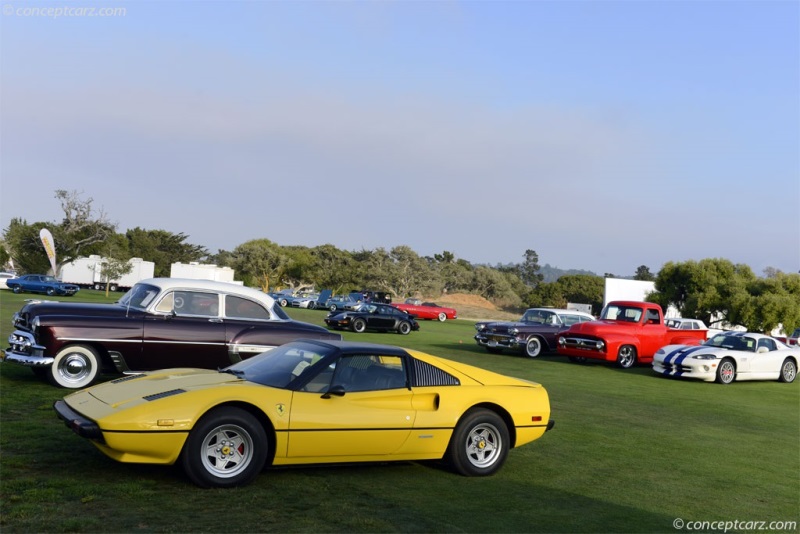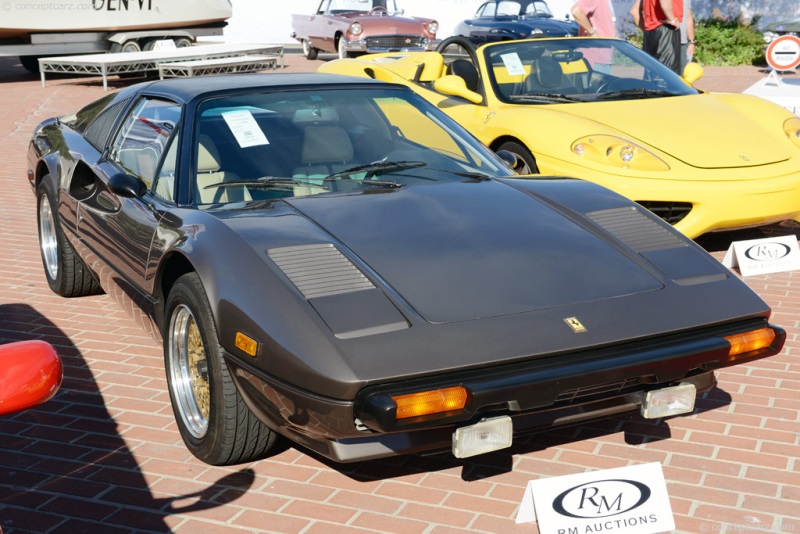History
For the initial 18 months of the 308 GTB's production, fiberglass was predominately used for the bodies, but later switched to all-metal. The fiberglass bodies were around 125 kg lighter.
The 308 was capable of producing 255 bhp from its 3 liter, V8, carburetor engine. In 1980, a Bosch K-Jetronic fuel injection system was installed due to new emission regulations. This caused the horsepower to drop to around 215 hp, thus making the 308 GTBi the slowest of the 308 series.
In 1981, Ferrari introduced 4 valve heads for the 3 liter V8's. This 308's now became known as 308 GTB/GTS Quattrovalvole. The engine now produced 240 BHP, and with the extra weight that was imposed due to using all-metal rather than fiberglass, the performance and handling was back to where it was when it began production.
In 1985, Ferrari introduced the 328 GTB/GTS. A vehicle that came equipped with a 3185 cc engine that produced 270 BHP.
By Daniel Vaughan | Nov 2010
The 308 was capable of producing 255 bhp from its 3 liter, V8, carburetor engine. In 1980, a Bosch K-Jetronic fuel injection system was installed due to new emission regulations. This caused the horsepower to drop to around 215 hp, thus making the 308 GTBi the slowest of the 308 series.
In 1981, Ferrari introduced 4 valve heads for the 3 liter V8's. This 308's now became known as 308 GTB/GTS Quattrovalvole. The engine now produced 240 BHP, and with the extra weight that was imposed due to using all-metal rather than fiberglass, the performance and handling was back to where it was when it began production.
In 1985, Ferrari introduced the 328 GTB/GTS. A vehicle that came equipped with a 3185 cc engine that produced 270 BHP.
By Daniel Vaughan | Nov 2010
The 308 was Ferrari's first two-seat V8 road car. Made available to the public in 1975, it was the long awaited successor to the incomparable Dino 246 GT. The 308 series was a new beginning for the company as the premier builder of exotic sports cars for road use. As such, the 308 was designed to epitomize the sports car in its era. It did so admirably, and remains perhaps the most influential enthusiast car in history. The 308 is the car against which every subsequent sports car has been measured, upon which every Ferrari V8 sports and racing car has been based, and the car that brought Ferrari from the pinnacle of elite car-culture recognition into the minds of the general public. 25 years later, the shape and sound of the 308 is still 'Ferrari' in the minds of many people.
Design
The Ferrari 308 GTS provided Pininfarina with an opportunity to flex its design and styling muscle. The company responded by redefining the public's collective impression of what a Ferrari, and indeed what a sportscar, should look like. The task given Pininfarina was the creation of a two-seat mid-engined V8, and few can have expected the Turin designer to respond with such a tour de force.
The 308's shape bears a passing resemblance to Pininfarina's Dino 246 GT. Where the older car was the ultimate expression of curvaceous 1960's styling, the 308 hinted far more at the future. From its sharp nose incorporating a slim bumper and a deep air dam, to its retractable headlights and row of black louvres that vent air from the radiator, the line flows up the windshield and out around the flanks to reunite
with itself at the buttress C-pillars, ending in a very subtle rear lip spoiler. The design is so beautiful and effective that it has been a basis for exterior styling of every subsequent V8 Ferrari and an object of study for design students the world over.
GTS models had louvered panels over the whole of their rear quarter windows. Increased venting front and rear served to improve cooling with each evolution of the engine. By and large, however, the design of the 308 was so iconic and effective that it was virtually unchanged throughout its decade of production.
Drivetrain
The heart of the 308 series was its three litre V8 engine. The 2926cc Ferrari V8 was something of a departure for the company, which had mostly relied on V12s. With the V8, Ferrari could offer much of the power of their legendary V12s while improving fuel economy and saving space. By placing the engine and transmission transversely Ferrari was able to reduce the length of their new sports cars and concentrate the mass within the wheelbase, a lesson of racing.
The transmission in the 308 was a five speed with reverse all synchromesh unit. Mounted transversely like the engine, the transmission received power through an unassisted single plate clutch. The gears sent power to the rear wheels through a limited slip differential and solid driveshafts with constant velocity joints.Source - Ferrari
Design
The Ferrari 308 GTS provided Pininfarina with an opportunity to flex its design and styling muscle. The company responded by redefining the public's collective impression of what a Ferrari, and indeed what a sportscar, should look like. The task given Pininfarina was the creation of a two-seat mid-engined V8, and few can have expected the Turin designer to respond with such a tour de force.
The 308's shape bears a passing resemblance to Pininfarina's Dino 246 GT. Where the older car was the ultimate expression of curvaceous 1960's styling, the 308 hinted far more at the future. From its sharp nose incorporating a slim bumper and a deep air dam, to its retractable headlights and row of black louvres that vent air from the radiator, the line flows up the windshield and out around the flanks to reunite
with itself at the buttress C-pillars, ending in a very subtle rear lip spoiler. The design is so beautiful and effective that it has been a basis for exterior styling of every subsequent V8 Ferrari and an object of study for design students the world over.
GTS models had louvered panels over the whole of their rear quarter windows. Increased venting front and rear served to improve cooling with each evolution of the engine. By and large, however, the design of the 308 was so iconic and effective that it was virtually unchanged throughout its decade of production.
Drivetrain
The heart of the 308 series was its three litre V8 engine. The 2926cc Ferrari V8 was something of a departure for the company, which had mostly relied on V12s. With the V8, Ferrari could offer much of the power of their legendary V12s while improving fuel economy and saving space. By placing the engine and transmission transversely Ferrari was able to reduce the length of their new sports cars and concentrate the mass within the wheelbase, a lesson of racing.
The transmission in the 308 was a five speed with reverse all synchromesh unit. Mounted transversely like the engine, the transmission received power through an unassisted single plate clutch. The gears sent power to the rear wheels through a limited slip differential and solid driveshafts with constant velocity joints.Source - Ferrari
Similar Automakers
Similarly Sized Vehicles
from 1979
1979 Ferrari 308 GTS Vehicle Profiles
Recent Vehicle Additions
Performance and Specification Comparison
Price Comparison
$23,875
$28,585
$85,000
$85,000
308 GTS Specification Comparison by Year
Year
Production
Wheelbase
Engine
Prices
Related Automotive News

Subaru announces pricing on 2024 BRZ sports car
New performance-focused BRZ tS trimEyeSight® Driver Assist Technology standard across model lineDynamic 2.4-liter SUBARU BOXER® engineli...

MASERATI HIGHLIGHTS AT GOODWOOD FESTIVAL OF SPEED 2014
Maserati Alfieri Concept takes centre stage in the Stable Yard for Maseratis centenary
Maserati A6GCS named best in show in the Cartier style-et-luxe concours delegance
Maserati MC12 Cent 100 driven by Michael Bartels wins class and second...

Friday Highlights At Goodwood Festival Of Speed
Goodwood, 12 July - Scuderia Ferrari driver Marc Gené will be demonstrating the F10 (chassis no.285) as part of the Contemporary Grand Prix Cars class at this years Goodwood Festival of Speed which starts today. Chassis no.285 was piloted by...

FERRARI IN ACTION AT GOODWOOD
Goodwood 11 July - Ferrari will be at the Goodwood Festival of Speed this weekend offering spectators a chance to see a wide range of innovative products bearing the Prancing Horse. Crowds in excess of 180,000 are expected for the event and with...

Six Decades Of Ferrari At Mecum's Daytime Auction
1954 Ferrari 750 Monza Headlines Select Offering of Italian Illuminati
Mecum Auctions will present its 4th annual Monterey Daytime Auction, Aug. 16-18, 2012 at the Hyatt Regency Monterey Hotel and Spa on Del Monte Golf course, featuring some...


































